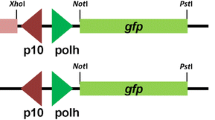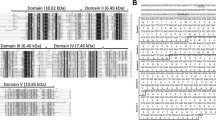Abstract
Bovine alphaherpesvirus type 5 (BoHV-5) is one of the main agents responsible for meningoencephalitis in cattle in Brazil, causing significant economic losses. It is known that other viruses of the Herpesviridae family such as Bovine alphaherpesvirus type 1, Swine alphaherpesvirus type 1, and the Human alphaherpesvirus types 1 and 2 encode genes homologous to BoHV-5, with recognized action in the control of apoptosis. The objective of this work was to express the BoHV-5 US3 gene in a baculovirus-based expression system for the production of the serine/threonine kinase protein and to evaluate its activity in the control of apoptosis in vitro. A recombinant baculovirus derived from the Autographa californica multiple nucleopolyhedrovirus (AcMNPV) containing the US3 gene and a deletion in the baculovirus anti-apoptotic p35 gene was constructed using the Bac-to-Bac™ system. This recombinant baculovirus was used to evaluate the anti-apoptotic activity of the recombinant US3 protein in insect cells comparing with two other AcMNPV recombinants, one containing a functional copy of the AcMNPV anti-apoptotic p35 gene and an AcMNPV p35 knockout virus with the anti-apoptotic iap-3 gene from Anticarsia gemmatalis multiple nucleopolyhedrovirus (AgMNPV). We found that the caspase level was higher in insect cells infected with the US3-contanining recombinant virus than in cells infected with the AcMNPV recombinants containing the p35 and iap-3 genes. These results indicate that the BoHV-5 US3 protein kinase gene is not able to block apoptosis in insect cells induced by the infection of a p35 knockout AcMNPV.






Similar content being viewed by others
References
French EL (1962) A specific virus encephalitis in calves: isolation and characterization of the causal agent. Aust Vet J 38:216–221
Del Médico Zajac MP, Ladelfa MF, Kotsias F, Muylkens B, Thiry J, Thiry E, Romera SA (2010) Biology of bovine herpesvirus 5. Vet J 184:138–145 Elsevier
Griffin BD, Verweijj MC, Wiertz EJ (2010) Herpesvirus and imunnity: the art of evasion. Vet Microbiol 143:89–100 Elsevier
Jones C (1998) Alphaherpesvirus latency: its role in disease and survival of the virus in the nature. Adv Virus Res 51:47–99
Ciacci-Zanella J, Stone M, Henderson G, Jones C (1999) The latency-related gene of bovine herpesvirus 1 inhibits programmed cell death. J Virol 73:9734–9740
Deruelle MJ, Favoreel HW (2011) Keep it in the subfamily: the conserved alphaherpesvirus US3 protein kinase. J.Gen.Virol. 92:18–30
Kato A, Yamamoto M, Ohno T, Kodaira H, Nishiyama Y, Kawaguchi Y (2005) Identification of proteins phosphorylated directly by the Us3 protein kinase encoded by herpes simplex virus 1. J Virol 79(14):9325–9331
Murata T, Goshima F, Yamauchi Y, Koshizuka T, Takakuwa H, Nishiyama Y (2002) Herpes simplex virus type 2 US3 blocks apoptosis induced by sorbitol treatment. Microbes Infect 4:707–712
Deruelle MJ, Geenen K, Nauwynck HJ, Favoreel HW (2007) A point mutation in the putative ATP binding site of the pseudorabiesvirus US3 protein kinase prevents Bad phosphorylation and cell survival following apoptosis induction. Virus Res 128:65–70
Schumacher D, McKinney C, Kaufer BB, Osterrieder N (2008) Enzymatically inactive US3 protein kinase of Marek’s disease virus (MDV) is capable of depolymerizing F-actin but results in accumulation of virions in perinuclear invaginations and reduced virus growth. Virology 375:37–47
Munger J, Roizman B (2001) The US3 protein kinase of herpes simplex virus 1 mediates the posttranslational modification of BAD and prevents BAD-induced programmed cell death in the absence of other viral proteins. Proc Natl Acad Sci 98:10410–10415
Cartier A, Komai T, Masucci MG (2003a) The Us3 protein kinase of herpes simplex virus 1 blocks apoptosis and induces phosporylation of the Bcl-2 family member Bad. Exp Cell Res 291:242–250
Cartier A, Broberg E, Komai T, Henriksson M, Masucci MG (2003b) The herpes simplex virus-1 Us3 protein kinase blocks CD8 T cell lysis by preventing the cleavage of Bid by granzyme B. Cell Death Differ 10:1320–1328
Kato A, Kawaguchi Y (2018) Us3 protein kinase encoded by HSV: the precise function and mechanism on viral life cycle. In: Kawaguchi Y, Mori Y, Kimura H (eds) Human Herpesviruses. Advances in experimental medicine and biology, vol 1045. Springer, Berlin
Takashima Y, Tamura H, Xuan X, Otsuka H (1999) Identification of the US3 gene product of BHV-1 as a protein kinase and characterization of BHV-1 mutants of the US3 gene. Virus Res 59:23–34
Ladelfa MF, Kotsias F, Del Médico Zajac MP, Broeke CV, Favoreel H, Romera SA, Calamante G (2011) Effect of the US3 protein of bovine herpesvirus 5 on the actin cytoskeleton and apoptosis. Vet Microbiol 153:361–366
Brzozowska A, Lipińska AD, Derewońko N, Lesiak D, Rychłowski M, Rąbalski L, Bieńkowska-Szewczyk K (2018) Inhibition of apoptosis in BHV-1-infected cells depends on Us3 serine/threonine kinase and its enzymatic activity. Virology 513:136–145
Flores EF, Donis R (1995) Isolation of a mutant MDBK cell line resistant to bovine virus diarrhoea virus (BVDV) due to a block in viral entry. Virology 208:565–575
Salvador SC, Lemos RAA, Riet-Correa F, Roehe PM, Osório ALA (1998) Meningoencefalite em bovinos causada por herpesvírus bovino 5 no Mato Grosso do Sul e São Paulo. Pesqui Vet Bras 18(2):75–82
Granados RR, Guoxun L, Derksen ACG, MecKenna KA (1994) A new insect cell line from Trichoplusia ni (BTI-Tn-5B1-4). Susceptible to Trichoplusia ni single enveloped nuclear Polyhedrosis virus. J Invertebr Pathol 64:7
Vaughn JL, Goodwin RH, Tompkins GJ, McCawley P (1997) The establishment of two cell lines from the insect Spodoptera frugiperda (Lepidoptera; Noctuidae). Vitro 13(4):213–217
Hopkins R, Esposito D (2009) A rapid method for titrating baculovirus stocks using the Sf-9 easy titer cell line. Biotechniques 47:785–788
Muylkens B, Thiry J, Kirten FS, Thiry E (2007) Bovine herpesvirus 1 infection and infectious bovine rhinotracheitis. Vet Res., France 38:181–209
Clem RJ, Miller LK (1994) Control of progammed cell death by the baculovírus genes p35 and iap. Mol Cell Biol 14:5212–5222
O’Reilly D, Miller LK, Luckow VA (1992) Baculovirus expression vectors: a laboratory manual. Freeman and Company, New York
Ardisson-Araújo DMP, Melo FL, Clem RJ, Wolff JLC, Ribeiro BM (2015) A betabaculovirus-encoded gp64 homolog is a functional envelope fusion protein. J Virol 90:JVI. 02491–JVI. 02415
Purves FC, Longnecker RM, Leader DP, Roizman B (1987) Herpes simplex virus 1 protein kinase is encoded by open reading frame US3 which is not essential for vírus growth in cell culture. J Virol 61:2896–2901
Daikoku T, Yamashita Y, Tsurumi T, Maeno K, Nishiyama Y (1993) Purification and biochemical characterization of the protein kinase encoded by the US3 gene of herpes simplex virus type 2. Virology 197(2):685–694
Chejanovsky N (2016) Using the Baculovirus/insect cell system to study apoptosis. Methods Mol Biol 1350:477–489
Yan F, Deng X, Yan J, Wang J, Yao L, Iv S, Qi Y, Xu H (2010) Functional analysis of the inhibitor of apoptosis genes in Antheraea pernyi nucleopolyhedrovirus. J Microbiol 48:199–205
Carpes MP, de Castro MEB, Soares EF, Villela AG, Pinedo FJR, Ribeiro BM (2005) The inhibitor of apoptosis gene (IAP-3) of Anticarsa gemmatalis multicap-sid nucleopolyhedrovirus (AgMNPV) encodes a functional IAP. Arch Virol 150:1549–1562
Geenen K, Favoreel HW, Olsen L, Enquist LW, Nauwynck HJ (2005) The pseudorabies virus US3 protein kinase possesses anti-apoptotic activity that protects cells from apoptosis during infection and after treatment with sorbitol or staurosporine. Virology 331:144–150
Brzozowska A, Rychlowski M, Lipinska AD, Bienkowska-Szewczyk K (2010) Point mutations in BHV-1 Us3 gene abolish its ability to induce cytoskeletal changes in various cell types. Vet Microbiol 143:8–13
Marin MS, Leunda MR, Verna AE, Faverín C, Pérez SE, Odeón AC (2012) In vitro replication of bovine herpesvirus types 1 and 5. J Virol Methods 181(1):80–85
Rensetti DE, Marin MS, Morán PE, Odeón AC, Verna AE, Pérez SE (2018) Bovine herpesvirus type 5 replication and induction of apoptosis in vitro and in the trigeminal ganglion of experimentally-infected cattle. Comp Immunol Microbiol Infect Dis 57:8–14
Funding
This work was supported by Fundação de Apoio à Pesquisa do Distrito Federal- FAPDF (process number: 0193.001235/2016, FAPDF number: 1063/2016) and Coordenação de Aperfeiçoamento de Pessoal de Nível Superior –CAPES.
Author information
Authors and Affiliations
Corresponding author
Ethics declarations
Conflict of interest
The authors declare that they have no conflict of interest.
Additional information
Responsible Editor: Giliane Souza Trindade.
Publisher’s note
Springer Nature remains neutral with regard to jurisdictional claims in published maps and institutional affiliations.
Electronic supplementary material
Fig. 1
(PNG 166 kb)
Fig 1
qPCR quantitation of intracellular viral DNA in Sf-21 insect cells infected with different recombinant AcMNPV baculoviruses after 0, 24, 48 h.p.i. Data represent the mean (± standard deviation, SD) of independent experiments, each performed in triplicate. Error bars indicate SDs. Abbreviations: Acpg: AcPG virus; P35: AcMNPVΔP35 virus; IAP-3: AcMNPVΔP35.IAP3; US3: AcMNPVΔP35.US3. (TIF 52 kb)
Table 1
Cell lines and recombinant baculovirus (PDF 156 kb)
Rights and permissions
About this article
Cite this article
Silva, A.M., Morgado, F.S., Silva, L.A. et al. Evaluation of the anti-apoptotic activity of bovine alphaherpesvirus type 5 US3 protein kinase in insect cells using a recombinant baculovirus. Braz J Microbiol 51, 827–835 (2020). https://doi.org/10.1007/s42770-019-00215-x
Received:
Accepted:
Published:
Issue Date:
DOI: https://doi.org/10.1007/s42770-019-00215-x




